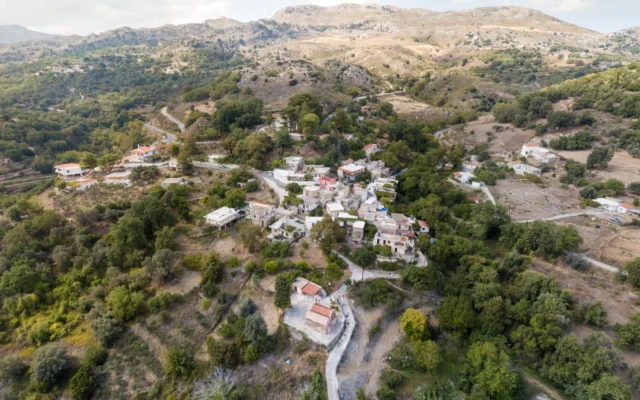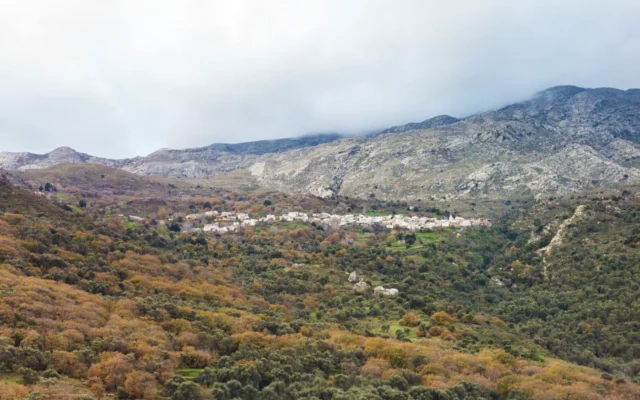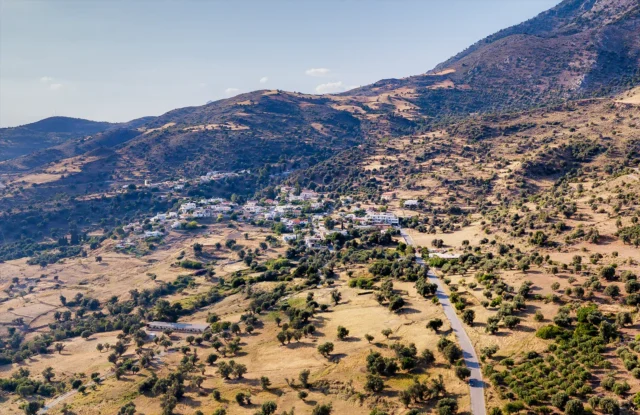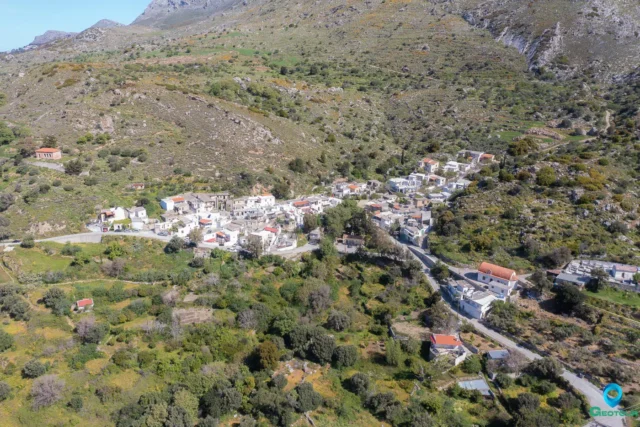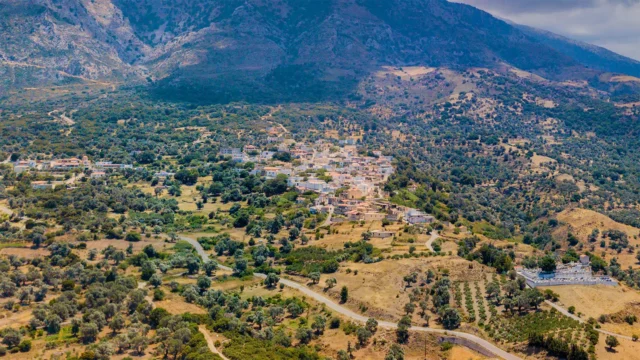71
listings found
Categories
Active filters:
Elenes, Amari
Elenes, situated in Crete's Amari Valley, 37km southeast of Rethymno, is a village with a rich history dating back to Minoan times, as evidenced by archaeological findings. The village, first noted in 1577 as Selenes, features significant Byzantine-era monuments like Agios Nikolaos church with 13th-century frescoes. Historical records show population fluctuations, with current inhabitants engaged in agriculture, maintaining the village's traditional character. The name likely derives from churches dedicated to Agia Eleni. Elenes has seen various administrative changes, now part of Amari Municipality since 2011.
Agios Ioannis, Amari
In Amari, Rethymno, 56km from Rethymno city (370m alt.), near Platy & Xife rivers crossed by old bridges like Manouras (Egyptian era, preserved). Venetian records include Barozzi (1577, S. Z(uann)e Chiliaru) & Kastrofylakas (1583, S. Giovanni Ghliafu). Kartsali has unexcavated Minoan Megaron remnants; Aigianniiotiki korifi features varied period sherds and possible 5th C. basilica ruins. The cemetery Church of Agios Ioannis, its namesake, shows 14th & early 15th C. frescoes (Nativity of John the Forerunner), suggesting a c.1285 monastery katholikon. The parish church Agioi Tesseres dates to the late 19th C. A primary school operated from 1899-1986. The village festival is on August 29th. Noted native: Emmanouil Papadogiannis, Greek Minister (1948-1950). It has been a community seat since 1925.
Ano Meros, Amari
Ano Meros is a settlement located in the Rethymno regional unit on the island of Crete, Greece. It belongs to the Municipality of Amari
Drygies, Amari
Drygies, a small village in the Amari Municipality of Rethymno, Crete, has historical mentions dating back to Francesco Barozzi in 1577. 1 Venetian censuses of 1583 recorded its inhabitants and corvée labor. The village was later noted in the 1834 Egyptian census and the 1881 Greek census. Part of the Ano Meros community for a significant period, Drygies faced destruction by German forces in 1944 following the Kreipe abduction, though villagers evacuated beforehand. The village church is dedicated to the Annunciation. Nearby features include the scenic Smiliano Gorge with waterfalls, the natural beauty of Platys Potamos, scattered chapels, and an ancient olive grove with uniquely shaped trees, near which lies the Byzantine Chapel of Agios Nikolaos with unrestored frescoes. Population figures show a decline from 92 in 1900 to 26 in 2011.
Chordaki, Amari
Chordaki, also known as Chordakion, is a small village in the Amari municipality of Rethymno, Crete. Its history is documented from 1372, during Venetian rule, through Ottoman occupation, and into modern Greece. The village includes the churches of Agia Anna and Panagia Faneromeni, the latter containing frescoes and a 1634 inscription mentioning monks Meletios and Konstantinos Varouchas. Population records exist from 1583, showing fluctuations under different regimes, down to a current population of 5. A primary school operated here from 1950 to 1970.
Mesonisia, Amari
Mesonisia is a settlement located in the Rethymno regional unit on the island of Crete, Greece. It belongs to the Municipality of Amari
Vizari, Amari
Vizarion is a settlement located in the Rethymno regional unit on the island of Crete, Greece. It belongs to the Municipality of Amari
Petrochori, Amari
Petrochori is a settlement located in the Rethymno regional unit on the island of Crete, Greece. It belongs to the Municipality of Amari
Gerakari, Amari
Gerakari is a settlement located in the Rethymno regional unit on the island of Crete, Greece. It belongs to the Municipality of Amari
Opsigias, Amari
Opsigias is a settlement located in the Rethymno regional unit on the island of Crete, Greece. It belongs to the Municipality of Amari
Platania, Amari
Platania is a settlement located in the Rethymno regional unit on the island of Crete, Greece. It belongs to the Municipality of Amari
Lochria, Amari
Lochria is a settlement located in the Rethymno regional unit on the island of Crete, Greece. It belongs to the Municipality of Amari
Platanos, Amari
Platanos is a settlement located in the Rethymno regional unit on the island of Crete, Greece. It belongs to the Municipality of Amari
Patsos, Amari
Patsos is a settlement located in the Rethymno regional unit on the island of Crete, Greece. It belongs to the Municipality of Amari.
Platanes, Agios Vassilios
Located on the southern foothills of Mount Kentros in Rethymno, at an altitude of 537 meters. First documented in 16th-century Venetian censuses, the settlement features the 13th-century Church of the Holy Cross. The surrounding area is defined by Mount Kentros, part of the Natura 2000 network, and includes sites linked to the hero Digenis Akritas, like the Cave of Digenis (a former Minoan worship site) and the impressive Richtra of Digenis, a 70-meter waterfall within the Platanes gorge.
Nefs Amari, Amari
Amari, a Cretan village at 460m, has origins from antiquity, with mentions in 1225 and Venetian records. It became Nevs Amari under Ottoman rule, serving as a capital. A resistance hub in WWII, it saw German destruction in 1944. Its name may derive from Latin "love" or a ruler. Key sites include Byzantine churches (Agia Anna, Agios Theodoros, Agioi Anargyroi, Kera Panagia), Asomaton Monastery, and a Venetian bell tower. Once a center of learning, it now focuses on agriculture, maintaining authentic Cretan traditions. Population fluctuated, currently at 111.
Fourfouras, Amari
Located in the Amari Municipality of Rethymno, Crete, this village is situated on the western foothills of Mount Psiloritis at an altitude of 460 meters, offering views of the Amari Valley. First mentioned in the 1583 Venetian census, it is now the largest village in Amari with 513 residents. It serves as the historical seat of the municipality and the second seat of the Holy Metropolis of Lampe, Syvritos, and Sfakia. Today, it is a commercial hub with a Town Hall, medical center, schools, and numerous businesses. A popular starting point on the European path E4 for climbing Psiloritis.
Panagia Mavridiani in Meronas
Panagia Mavridiani, or Church of the Nativity of Mary, stands near Meronas, Crete, with origins in the 13th century, expanded in the 15th and 16th. The church features two aisles; the older, 13th-century section displays Byzantine architecture with a domed, single-nave design and 13th-century fresco remnants. The northern aisle, dedicated to Saints Constantine and Helen, was added in the 16th century. Frescoes, though partially lost, portray scenes like the Nativity of Mary, Annunciation, Ascension, and Second Coming, alongside saints such as Gregory, Romanos, and Panteleimon. Restored in 2012, it is a testament to Byzantine artistic and religious heritage.
Meronas
Meronas, in Rethymno's Amari valley, features a rich history from antiquity to Ottoman rule. Notable are Byzantine churches with 14th-16th century frescoes, a Venetian-era tower, and the 19th-century Koules. The village's cultural association preserves traditions with events like Carnival, Easter celebrations, and music schools. Historical records date to 1301, with population fluctuations noted from the 16th to 21st centuries. The village includes the churches of Assumption of the Virgin Mary, Panagia Mavridiani, and Saint Panteleimon, showcasing varied architectural and artistic periods.
Moni Asomaton monastery
Located in the Amari Valley, 35 km from Rethymno, this monastery is dedicated to the Synaxis of the Archangels. The katholikon (main church) represents a unique Franco-Byzantine style. Originally a 14th-century barrel-vaulted church built on 10th-century foundations destroyed in the 1303 earthquake, it was later transformed into a cross-in-square church. Historically, it was linked to the Varouchas family, served as the seat of the Bishop of Lampe, and became an agricultural school in 1927. After nearly a century, it officially reopened in May 2024.









